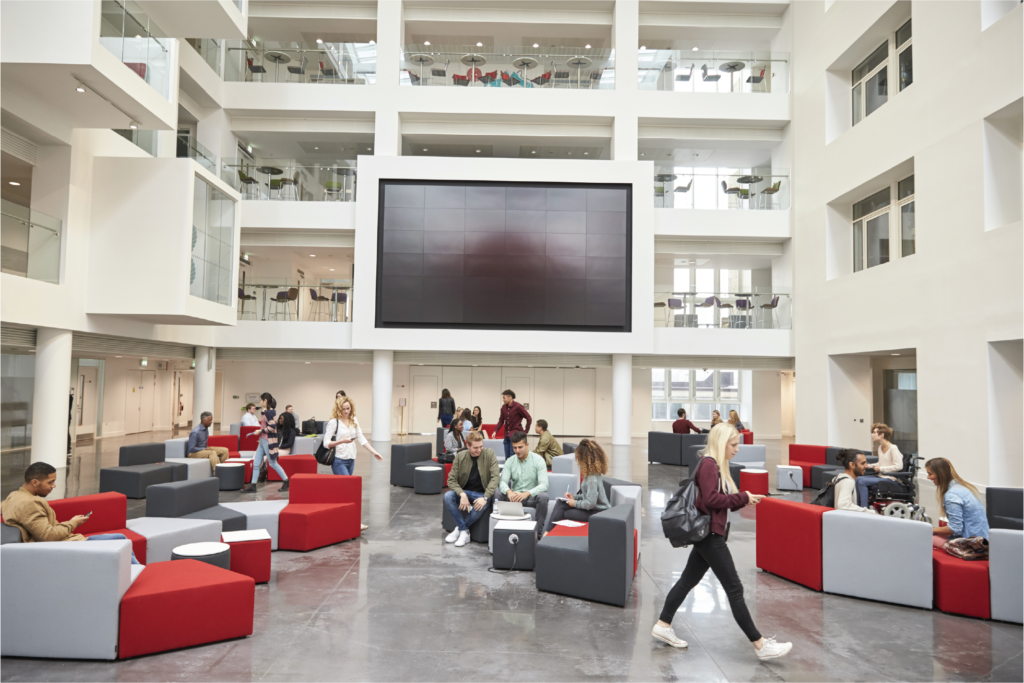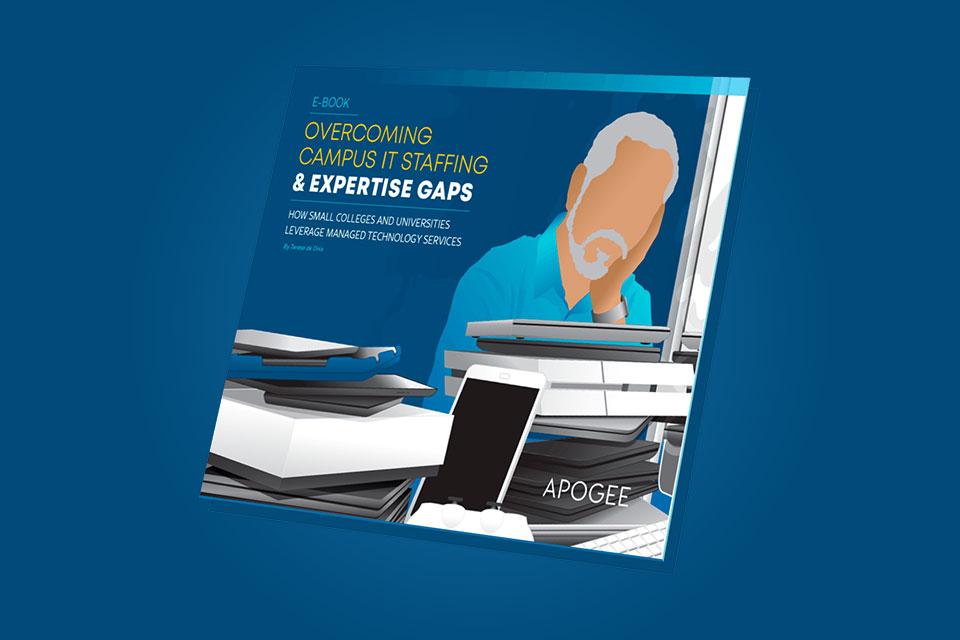HOW WILL YOU MEET GEN Z TECHNOLOGY DEMANDS?
In an essay published in The Chronicle of Higher Education, co-authors Arthur Levine and Scott Van Pelt outline five “profound and jarring new realities” shaping the future of higher education. While each of these trends – the result of conversations with college presidents, higher ed associations, and policymakers – are broadly relevant for school administrators, one trend stands out among the rest:
“With near universal access to digital devices and the internet, students will seek from higher education the same things they are getting from the music, movie, and newspaper industries.”
The commonality among these three industries isn’t hard to detect. Each has developed options for on-demand, unbundled access in response to consumer wants and needs (e.g., think buying a song on the go rather than the entire album from a fixed location). Digital natives prefer anytime, anyplace access. Service, quality, affordability, and only being charged for services they use, are natural outcroppings of this preference.

One can see how Generation Z, immersed in and attuned to this style of consumerism, would carry these same preferences with them to college. In fact, Levine and Van Pelt argue that as the demands on students’ time outside of school increase, an affordable educational experience that adapts to them is the sort most likely to capture their attention. So, what does this mean for attracting and retaining students to on-campus residence halls?
This trend reinforces the idea that Gen Z expectations are rooted in connectivity. Or, at the very least, in the things that connectivity enables. In the context of their consumer preferences, a personalized experience and greater flexibility and control are obvious wants. Communication, collaboration, and a sense of community could round out a typical list. All together, these connectivity-enabled benefits are the foundation of a compelling on-campus experience.
It makes sense then that administrators, housing leaders, and IT organizations would place a premium on their residence hall Wi-Fi. Incoming students, with their myriad devices, high bandwidth consumption, and demands for persistent connectivity – and that all their devices (printers, media players, gaming systems) all talk to each other – won’t set aside those expectations when they leave home. And yet many schools are content to try to manage this service in-house, relying on already overburdened and understaffed IT teams to rise up to the challenges Gen Z will create – and that the COVID-19 pandemic has only accelerated. One classic conflict for IT leaders is whether they need an “enterprise network” in the residence halls. Having a separate student network without all the enterprise configurations helps IT from a support and security perspective while providing students with the truly connected experience they want in their living spaces. How prepared is your residence hall network to contribute to this?

Rethinking residence hall Wi-Fi.
Residence hall leaders and higher ed IT teams frequently view residence hall Wi-Fi as a service only they can design and manage. Indeed, these networks are unique in the sense that the physical spaces they occupy vary widely, the end users they support arrive with usage behaviors unlike any other segment, and stakeholders include not only on-campus students themselves but often their families. All these characteristics have a similarly unique impact on network design, installation, and ongoing support.
It can be difficult to stray from internally managed network models that have evolved over time to respond to evolutionary changes in student needs and corresponding technology requirements like higher bandwidth and improved performance. But this thinking only ensures the status quo when transformation is needed. The evidence is overwhelming that incoming Gen Z students view connectivity as central to their lives, so it’s time to rethink the way residence hall Wi-Fi is delivered.
Superior Wi-Fi is foundational to student life.
It’s important for residence hall decision-makers to look beyond the evolving technical usage requirements of residence hall Wi-Fi (e.g., multi-device support, higher bandwidth) to consider the specific ways incoming students rely on connectivity to live their lives. Only then can you design, deploy, and manage a network that delights your on-campus residents while reducing or eliminating student or family-member complaints.
Study, research, and collaboration
As the digital natives they are, Gen Z approaches their academic life through the lens of connectivity. Whether researching topics for a paper, seeking out the opinions of classroom peers, or doing both at the same time with Netflix humming softly in the background, residence hall students depend on a robust, always-available Wi-Fi connection that just works.
Consider the last year of synchronous online class work: Expectations for a persistent, high-bandwidth connection were heightened. Moreover, as blended learning continues to grow as a response to student desire for flexibility and adaptability, and classroom study continues to occasionally expand beyond the physical classroom itself, even a temporary drop in connectivity can have a rippling effect.
The growth of living and learning communities — shown to have a positive impact on student retention — likewise places a premium on underlying Wi-Fi connectivity. Wherever Gen Z’s academic requirements take them, their dependence on reliable connectivity makes providing a robust, flexible, and evolving network a necessity.

Wellness and Mental Health
Generation Z are children of The Great Recession. They’ve grown up seeing their Gen X parents deal with the repercussions of job loss and a challenging economy. Their frugality and pragmatism are a direct result of this experience, as are their expectations for return on the dollars they invest in their education. It’s perhaps because of this same experience that Gen Z places a premium on self-care.
In the smartphone era, self-care is easier and more accessible than ever. Incoming students, confident in their ability to explore new services, rely on a multitude of digital apps and offerings to support their overall health and mental well-being. Especially true for incoming students who rely on public transportation or a friend with a car, access to telehealth services, meditation and workout apps, and other wellness-focused digital tools is essential. Once more, reliable and persistent connectivity is mission critical.

Socialization and Community
From text messaging to Instagram and Group Chat, and a multitude of apps and services in between, Gen Z relies on no single tool to communicate with peers, make new friends, or socialize with their wide circle of fellow students and acquaintances. Often eschewing more traditional or formal outreach from campus sources, students participate in campus group chats to get information, ask questions, and socialize in real time. Immediacy is a table stake.
The sense of community created by these digital interactions is important to the wellbeing of on-campus students, especially those new to campus life. It feeds socialization and community-building in the non-digital world, too, making those early, online connections important in enabling a fulfilling on-campus experience. Here again, reliable, high-bandwidth connectivity is essential, keeping students consistently connected whether they’re roaming the halls of their dorm or connected through multiple devices in their room.

Downtime and Entertainment
The typical Gen Z student arrives on campus with a multitude of devices, from smartphones to tablets, laptops to gaming systems. It’s not out of the ordinary for a resident of your on-campus housing to stream Netflix on a laptop or smart TV and play Madden on an Xbox, while simultaneously FaceTiming with a friend down the hall doing all of the same. Whatever the circumstances, think multi-device, bandwidth-hogging connectivity.
Entertainment and downtime connectivity likely trails academics by only a slim margin in terms of end-user importance. Driving for a touchdown only to have the game lag or shut down because of a slow or lost Wi-Fi connection will not draw positive reviews in student-centered social media circles. This is true not just for the gamers among your Gen Z residents, but those streaming shows, connecting with friends, or participating in other forms of online entertainment.
The residence hall of the future demands a new approach.
Evolving your residence hall Wi-Fi to not only respond to incoming student needs but get ahead
of them requires breaking out of your current approach. The harsh reality is that while IT budgets remain flat and understaffed IT teams continue to shrink, designing, deploying and supporting a next-generation Wi-Fi network in-house is too high a mountain to climb. Outsourcing your residence hall network to an expert managed services provider (MSP) can help.
If you’ve previously dismissed the idea of outsourcing to a third-party because you believe the unique demands of your infrastructure are too complex or because of concerns about cost, now is the time to reconsider. The right MSP can tackle these challenges head on, taking on the risk of designing and deploying a scalable network that is future proofed against inevitable bandwidth, performance, capacity, and coverage increase requirements and do so within the confines of your existing annual budgeting process.
When exploring the possibility of outsourcing, it’s essential to consider the following:

Focus on core objectives
The right MSP wears your colors, aligns with your goals, knows your culture, and most importantly, intimately understands the unique demands of the students you strive to attract and retain. Turning to an expert MSP resolves your residential Wi-Fi challenges while freeing IT staff to focus on strategic priorities impacting the future of your institution.

Get the expertise you need
New technology means new problems, problems your existing IT team may not have the knowledge or experience to solve. An MSP immersed in the needs of higher education and its students can help ensure your network infrastructure is up-to-date and always one step ahead of increasing performance and bandwidth demands.

Eliminate complaints
An often-overlooked benefit of working with a solid MSP is the ability to significantly reduce or even eliminate student and parent complaints. With focused SLAs guaranteeing network speeds and performance, working with the right MSP with higher education experience and expertise can make complaints a thing of the past.
Moving forward with ResNet
Apogee pioneered ResNet and is the only MSP solely dedicated to higher education. Once you’ve made the decision to outsource, quantifying your needs in the following ways will help ensure project success.
Know what you’re buying.
This sounds like common sense advice but misunderstandings about the dynamics of your residence hall environment or the specific requirements for your infrastructure frequently lead to unsuccessful partnerships. Understand where the starts and stops of responsibilities exist to ensure accountability. Bring your “what-if” scenarios and listen for variations in approaches to best align with your culture and need. In any discussion with a potential provider, be as specific and clear as possible about your needs. This will make comparing MSPs easier and more straightforward, while dramatically increasing the potential for success post-deployment.
Look for higher education expertise.
Many MSPs will claim they understand your unique infrastructure demands. It’s your job to sift through the noise and get to the facts. Effectively answering the demands your residence hall Wi-Fi will face requires deep experience with the intricacies of higher education and the usage patterns of incoming students. From infrastructure design to support, you’ll need a partner who can act as an extension of your team without handholding from you or your staff.
Choose a funding model that works with you.
MSPs with deep experience in higher education understand the budget and funding challenges IT leaders face. In evaluating any MSP, look for funding models that take your specific challenges into account, that work with you instead of against you, and include rock-solid SLAs reflective of the higher ed experience the provider brings to the table that help ensure project success.
Streamline project deployment in 3 steps
Nothing is more disappointing than to make a well-reasoned decision for the betterment of your institution, only to see the results of your hard work stymied by unforeseen challenges once a decision is made. Through our two decades of experience in higher ed, we’ve uncovered three important inflection points in the buyer’s journey that, when accounted for in your planning, help speed the process from decision to project implementation. You should also consider the competitive cost of being slow to innovate as well as the opportunity cost of not addressing inefficiencies year after year.
While each of these steps in the process represent discrete points in the purchasing path, they all are equally essential with the power to make or derail a successful deployment. It’s important to think about each of them early and often, rather than delay addressing them, even as they may not each be critical to getting to a purchase decision.
1. The Funding Safari

Customers often tell us that the mechanics of organizing project funding internally slowed progress toward acquisition and deployment more than they’d initially expected. While it’s Apogee’s approach to address this issue up front with potential customers, it’s critical to think through the internal funding problem early.
Thinking through funding sources in advance seems obvious, yet many organizations delay this exercise too long, creating unnecessary delays in project progress. As early as possible, determine where your funding will come from. A centralized administrative budget? From an auxiliary service like housing? From your IT operations budget? Knowing the answer ahead of time can resolve issues before they happen.
In addition to properly identifying your funding sources early, you’ll also want to be prepared to accurately compare the costs of managing your own campus network to those of working with a managed services provider. This often requires a closer examination and reframing of your existing IT investments – and not limited to those occurring within the last couple of years.
For example, if you spent $500,000 in networking hardware five years ago but still rely on that investment today to power your network, then that investment should be included in your comparison. You’ll also need to consider costs beyond the equipment itself, including network design, circuits, installation costs, IT staff time, annual maintenance and support, licensing, and other associated costs.
DIY project management of networking infrastructure projects take up a tremendous amount of IT staff time and energy, particularly given the short windows that are open for big network upgrades in the academic calendar. If examining your investments in this kind of detail and sharing it with your potential provider is too painful, you may well already have the answer to whether outsourcing is right for you.

2. Purchasing
Understanding the purchase process at your institution and being as open and transparent about that process with your provider can help overcome any last-minute challenges as you work to close an agreement. What is the procurement path at your school? Does your school president or CFO need to sign off? Will an RFP be required? Are there paths to sole sourcing, piggybacking off existing contracts, or participating in a shared service agreement within a system or with partner schools? Engaging your procurement team early to answer these questions imperative.
If the answer to the RFP question is yes, it’s important to engage your MSP to help shape the details of the RFP itself. A generalized RFP will yield multiple responses from vendors with little to no knowledge of what is truly needed, while creating more work for you and your team to cull those that aren’t a fit. Likewise, ensuring that specific equipment or services essential to the success of your project are included in the RFP is equally important. A strong, experienced provider can help with this. While the RFP process can generate lower cost proposals, precious time is taken up to sort through the contenders and pretenders. A strong, experienced provider can help mitigate this.
Finally, engaging procurement leads early creates greater potential for meeting your timeline expectations. Like any other important stakeholder, procurement team members don’t like to be blindsided. Ensuring they’re up-to-speed with your project objectives and timeline goals up front creates tremendous momentum, enough to carry your project through quickly and efficiently once an agreement is reached.

3. Onboarding and Move-in

An overlooked part of a residential network deployment, onboarding and move-in can be pivotal in determining the longer-term success of your project. First impressions can be lasting. If incoming students don’t know how to connect or find it difficult to navigate the various Wi-Fi features offered, the performance and reliability you provide may not land with students the way you’d envisioned.
The right MSP should provide move-in and onboarding services and materials – print and digital – to ensure everything goes smoothly as planned. Be sure to ask potential partners what efforts will be made to ensure students know about the features of the network, how to connect, and where to go for support. You’ll also want to inquire to understand what processes or people the provider will offer to monitor move in, update on progress, and act as a liaison with IT or residence hall staff.
Meet Gen Z demands with Modern Wi-Fi
Evolving your residence hall network to meet the technology requirements of Gen Z demands a new approach. The old models of serving an admin network to students are not sustainable in an era in which persistent, high-performing connectivity is foundational to an engaging, effective and holistic on-campus experience. As housing and IT leaders grapple with how to adapt and respond, while also searching for ways to unlock the time needed for true innovation, outsourcing offers a way forward.
But making the strategic decision to outsource isn’t the end of the process; rather, it’s just the beginning. The success or failure of your residence hall network will depend on the planning and preparation you take into the process to ensure the right partner fit and get to project deployment fast and efficiently as possible.





